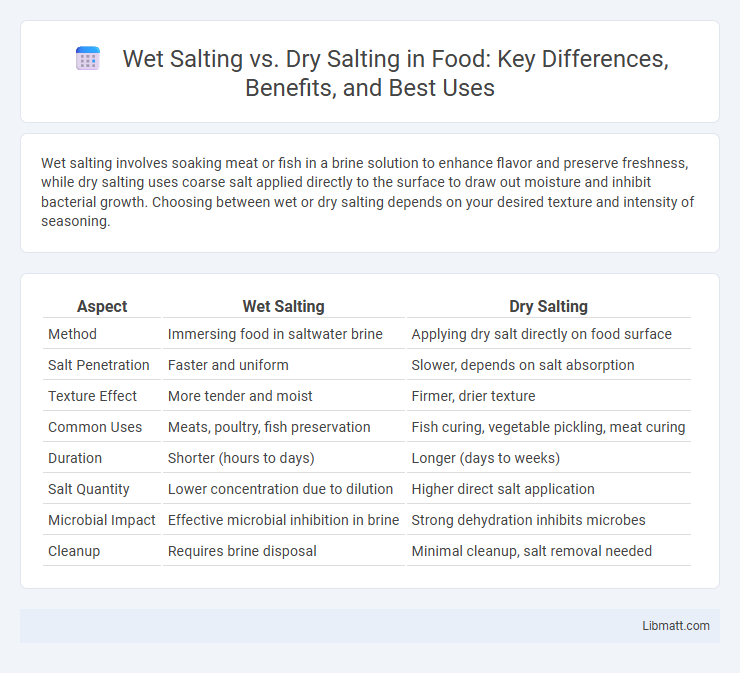Wet salting involves soaking meat or fish in a brine solution to enhance flavor and preserve freshness, while dry salting uses coarse salt applied directly to the surface to draw out moisture and inhibit bacterial growth. Choosing between wet or dry salting depends on your desired texture and intensity of seasoning.
Table of Comparison
| Aspect | Wet Salting | Dry Salting |
|---|---|---|
| Method | Immersing food in saltwater brine | Applying dry salt directly on food surface |
| Salt Penetration | Faster and uniform | Slower, depends on salt absorption |
| Texture Effect | More tender and moist | Firmer, drier texture |
| Common Uses | Meats, poultry, fish preservation | Fish curing, vegetable pickling, meat curing |
| Duration | Shorter (hours to days) | Longer (days to weeks) |
| Salt Quantity | Lower concentration due to dilution | Higher direct salt application |
| Microbial Impact | Effective microbial inhibition in brine | Strong dehydration inhibits microbes |
| Cleanup | Requires brine disposal | Minimal cleanup, salt removal needed |
Introduction to Salting Methods
Wet salting involves immersing food in a brine solution, allowing salt to penetrate evenly and retain moisture, ideal for meats and fish preservation. Dry salting uses coarse salt directly applied to the surface, drawing out moisture through osmosis and enhancing flavor and texture, commonly used for curing hams and bacon. Both methods are essential for food preservation, flavor enhancement, and extending shelf life in culinary practices.
What is Wet Salting?
Wet salting is a preservation technique where meat or fish is submerged in a brine solution containing water, salt, and sometimes sugar or spices, to inhibit bacterial growth and enhance flavor. This method allows the salt to penetrate evenly, maintaining moisture and texture better than dry salting. Commonly used in curing processes, wet salting is essential in producing products like corned beef and pickled herring.
What is Dry Salting?
Dry salting is a preservation method that involves applying coarse salt directly onto the surface of meat or fish to draw out moisture and inhibit bacterial growth. This technique intensifies flavor by concentrating the natural juices through osmosis, resulting in a firmer texture and enhanced taste. Commonly used in curing processes, dry salting requires careful timing to achieve optimal preservation without over-salting.
Key Differences Between Wet and Dry Salting
Wet salting involves soaking meat or fish in a brine solution, enhancing flavor and moisture retention through osmosis, while dry salting uses coarse salt directly applied to the surface, drawing out moisture to preserve and intensify texture. Wet salting typically requires refrigeration and fixed brine concentration, whereas dry salting allows for more flexible application and air-drying, influencing curing times and final product characteristics. The choice between wet and dry salting impacts preservation effectiveness, flavor profile, and product shelf life in meat and seafood processing.
Advantages of Wet Salting
Wet salting offers advantages such as more uniform salt distribution and faster curing times compared to dry salting. The brine solution enhances moisture retention in meat, improving texture and flavor while reducing spoilage. If you're looking to preserve meat efficiently, wet salting ensures better penetration and consistent results.
Benefits of Dry Salting
Dry salting preserves meat by drawing out moisture, which inhibits bacterial growth and extends shelf life without needing refrigeration. It enhances the flavor and texture of the meat, creating a more concentrated taste compared to wet salting methods. By choosing dry salting, you benefit from a traditional, low-moisture curing process that maintains product integrity over longer periods.
Best Applications for Wet Salting
Wet salting is best applied to large cuts of meat such as hams, pork shoulders, and whole fish where deep, even penetration of salt and curing agents is essential. This method enhances moisture retention and tenderness by allowing the brine to diffuse throughout the meat over time, making it ideal for products requiring longer curing periods. Wet salting is particularly effective in commercial food processing and artisanal charcuterie for producing consistent flavor and extended shelf life.
Ideal Uses for Dry Salting
Dry salting is ideal for curing meats like bacon, ham, and dry-cured sausages where moisture reduction is essential to prevent spoilage and enhance flavor concentration. It is commonly used in processes requiring long-term preservation and firm texture development, such as the production of prosciutto or country ham. This method works best in controlled environments with low humidity to ensure even salt penetration and effective dehydration.
Wet Salting vs Dry Salting: Health and Safety Considerations
Wet salting, involving brine solutions, reduces airborne dust, minimizing respiratory hazards and ensuring a safer working environment compared to dry salting, which generates dust particles that may cause lung irritation and occupational health risks. Wet salting also decreases the risk of fire and explosion in industrial settings since the moisture content suppresses dust flammability. Dry salting poses challenges with salt dust inhalation and environmental contamination, requiring stringent personal protective equipment and ventilation measures to safeguard worker health.
Choosing the Right Salting Method for Your Needs
Wet salting involves immersing food in a brine solution, providing even salt distribution and moisture retention, ideal for meats and vegetables requiring tenderization. Dry salting uses coarse salt directly applied to the surface, promoting dehydration and a concentrated flavor, suitable for curing and preserving. Selecting the right method depends on desired texture, flavor intensity, and preservation goals.
Wet Salting vs Dry Salting Infographic

 libmatt.com
libmatt.com